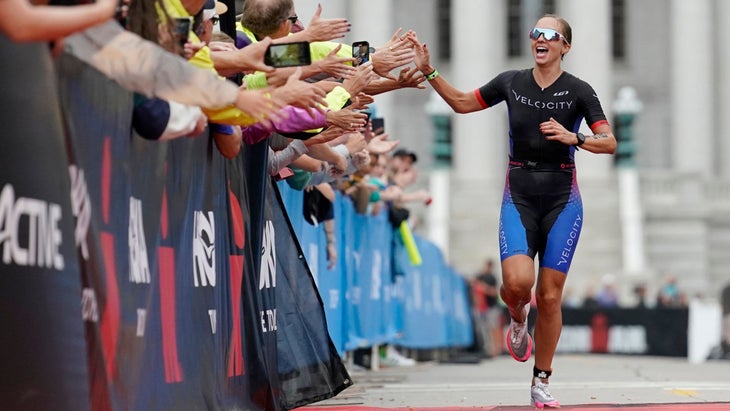[ad_1]
“], “filter”: { “nextExceptions”: “img, blockquote, div”, “nextContainsExceptions”: “img, blockquote”} }”>
Get access to everything we publish when you
>”,”name”:”in-content-cta”,”type”:”link”}}”>sign up for Outside+.
Annamarie Strehlow didn’t set out to be a triathlon champion. If anything, she thought her destiny was to be the next Mia Hamm.
“Like any young girl playing soccer in the late ’90s and early 2000s, I wanted to play for the U.S. Women’s National Team,” Strehlow said. She made it as far as the college ranks, playing at the University of St. Thomas, but then found a new passion—her studies as a physical therapy student. After graduating and taking a job in Milwaukee as a doctor of physical therapy, her passion for the work became even greater.
“As our area’s level 1 trauma center, I primarily treat patients recovering from traumatic injuries, but I also treat a variety of other diagnoses and chronic pain,” Strehlow said. “Being located in a major metropolitan area, I serve a diverse clientele, which in addition to caring for an injury, provides me the opportunity to address challenges occurring in our underserved population.”
The nature of her job meant things got very busy, very quickly for Strehlow. To claim some quiet time each day, she took up running. While training for the Milwaukee Lakefront Marathon, she sustained an Achilles injury that ended up changing her life for the better.
“During my recovery, my coach, Heather Haviland, suggested I aqua jog. When I went to the pool I noticed it was filled with elite triathletes and swimmers. I felt compelled to swim and embarrassed to aqua jog,” she said. This competitive urge ignited something in the former soccer star; she not only wanted to swim against the people in the pool, but she wanted to do the races they were doing. She took swim lessons, and a few months later, raced her first triathlon.
“I fell in love with the challenge of the sport and the support of the triathlon community,” Strehlow said. “I have been creating new goals ever since.”
Those goals were put on hold during the COVID-19 pandemic, but the pause in racing also allowed Strehlow to continue learning the ropes of triathlon. The extra study paid off. In 2021, she won the female overall title at USAT Age Group Nationals and Long Course Nationals. She was also the first female overall at Ironman Wisconsin—her first attempt at the distance. (Ironman Wisconsin didn’t have a pro field this year.)
So how does Strehlow maintain a high level of performance without sacrificing her passion for her work as a physical therapist? The secret is in the structure, she said.
“I am grateful for my coach, Heather, as she plans out my training days and weeks. From there, I plan my schedule, before and after work, as well as my weekends,” Strehlow said. “Leading up to race season, I typically plan my weekends a few weeks, if not months, ahead of time, as many are filled with long brick workouts. Additionally, I planned my weekdays from morning to evening. Time is precious during the week, because it goes very quickly, especially after work.”
Strehlow finds further efficiency in her schedule through preparation—meal prep happens on Sunday (“essential for high-volume weeks,” she said), she always keeps her gear at the ready for each day’s workout, and mental preparation is a cornerstone of her training plan.
RELATED: The Complete Guide to Meal Planning
“Physically my job can be demanding because I am on my feet nearly eight hours each work day, seeing between 11 to 13 patients,” Strehlow said. “My job can also be emotionally draining, as a large part of my patient population present with psychosocial concerns in addition to their physical ailments. I enjoy being a holistic healthcare provider, though it does bring with it another layer of fatigue beyond just the physical challenge of [my] work.”
To balance work and training, Strehlow schedules easy recovery days on Mondays, to allow her to ease into the work week without the added demands of training. She has also created a routine that takes the guesswork out of her day and lets her fully focus on the task immediately in front of her, whether that’s crushing a pre-work tempo run or helping a patient make breakthroughs in recovery.

“I wake up and go. I have my bags packed and meals prepped. This is the most efficient way to get in long training sessions both before and after work.”
5:00-5:15 a.m. – Quick pre-workout snack, get out the door
5:15-7:30 a.m. – Swim, or run, or bike, or a brick
8:30 a.m.-12:30 p.m. – Patient care
12:30-1:30 p.m. – Lunch, patient documentation, go for a short walk
1:30-5:00 p.m. – Patient care
5:30-7:00 p.m. – Bike or run
7:00-8:00 – Shower, dinner with my husband
8:00-8:30 p.m. – Meal prep and pack bags for the next day
8:30-9:00 p.m. – Relax, spend time my husband, stretch, mobility exercises, sometimes short yoga session
9:30 p.m. – Lights out
[ad_2]
Source link

